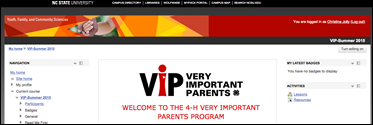 |
April 2016
|
April 2016 // Volume 54 // Number 2 // Tools of the Trade // v54-2tt3
Using Social Media to Engage and Educate Teen Parents
Abstract
Employing social media to engage youth in real-time learning is a growing trend. Although the use of social media by youth is increasing, barriers exist for Extension educators wanting to capitalize on youth interest in social media, including a lack of information on how best to employ social media in programming. This article highlights a teen parenting program's use of asynchronous learning through a variety of social media platforms.
Introduction
Cooperative Extension personnel have long been known to meet clients where they are. From the beginning days of Extension, agents went to families to help them meet their needs (Allen, Dunn, & Zaslow, 2011). For those working with youth, the increased use of technology creates both a challenge and an opportunity to meet youth where they are: online. Although there can be challenges and barriers to using social media in Extension, educators can benefit from using online networking tools (Kinsey, 2010). This article describes a teen parenting program's use of social media technologies to engage vulnerable youth.
Social Media in Education
Technology use constitutes an integral part of the average American teen's life. The majority of American teens now have access to a smartphone (73%) and/or a computer (87%), and 92% of American teens report going online on a daily basis (Lenhart, 2015). With increased access to the Internet and the upward trend of smart mobile devices, today's youth are continually engaged on social media platforms, especially Facebook, Instagram, and Snapchat. Also, they are frequently using mobile text messaging and text messaging applications (e.g., WhatsApp) to communicate, with the average teen sending and receiving 30 texts per day (Lenhart, 2015). These communication tools, while commonly used for leisure and social networking, also provide a means for seeking and sharing information and can be used to promote learning.
The pervasiveness of social media and technology provides an opportunity to engage youth in learning and educational experiences in a way that is both readily accessible and relevant. Social media platforms are now being used to establish learning communities that "empower students with a sense of personal agency in the learning process" (Dabbagh & Kitsantas, 2012, p. 5). Learning is promoted though constant communication and connectivity, peer/instructor collaboration, and opportunities for students to create and contribute personalized content (Gikas & Grant, 2013).
Case Study
There is an increasing requirement to help our vulnerable youth receive much-needed education to help with parenting and life and relationship skills. The North Carolina State University (NCSU) Very Important Parents (VIP) program uses a variety of social media technologies to support and deliver such programming. Meeting teens where they are creates an opportunity to help them learn in real time, using in-real-life, or IRL, situations. The VIP program has used a variety of social media platforms in a number of approaches to reach and teach teen parents.
To share parenting tips and education, the VIP program created a public Facebook page, which can be found at https://www.facebook.com/ncsuveryimportantparents. For each group of VIP program participants, however, a closed Facebook group is created. The relevant pages allow for more privacy for participants as they share stories about themselves and their children, and they are used to disseminate a weekly instructional video, daily questions, and weekly parenting activities. These pages also are used for dialogue between participants and parent coaches regarding various topics related to the curriculum and participant life experiences.
The VIP program created an Instagram account (@veryimportantparents) to stay connected with parents regardless of whether they are enrolled in the program. Figure 1 shows the image of an Instagram post from @veryimportantparents. Followers receive weekly parent/child activity suggestions that focus on building developmental skills in children and creating strong family connections.
Figure 1.
Instagram Post from NCSU VIP Program

YouTube
YouTube is becoming a site where many parents go to learn about new activities and ideas for their families. The VIP program team, which includes content specialists, parent coaches, and undergraduate work-study students, has produced 14 educational videos, in English and Spanish, for the Very Important Parents Program channel. The channel provides a resource for families to learn about parenting topics that are relevant to their daily experiences, presented using innovative technology, and rooted in parenting research.
Many of the young parents who are participating in the VIP program use a cell phone as a primary Internet source. WhatsApp is a free download from the app store for all phones that allows participants to receive text and video messages from the VIP program at no cost (i.e., without drawing from mobile data/text plans). This service is used to send weekly instructional videos and parenting information, as well as for regular communication between participants and their parent coaches. Figure 2 shows a @veryimportantparents WhatsApp post.
Figure 2.
WhatsApp Post from NCSU VIP Program

Canva
Finding new ways to present information can be challenging. Using web-based design tools, such as Canva (www.canva.com), to create engaging infographics has increased participation in program activities and has provided an exciting way to deliver educational materials and messages to participants. These colorful designs make learning more fun and accessible for all participants.
Additional Web-Based Tools
Program staff developed a central website, www.beVIP.org, to allow participants access to information before, during, and after completion of their participation in the program. This site provides free printable resources for parents and providers as well as video resources on parenting education.
VIP uses NCSU Moodle services (Figure 3) to implement programming for participants who are unable to access social media resources. Moodle requires only Internet access, and participants are able to view all materials and complete activities in one location.
Figure 3.
Moodle Post from NCSU VIP Program

Another resource used after the completion of the program is Daily Vroom (http://www.joinvroom.org/). This free application allows parents to receive daily messages that are tailored for each of their children and provides the family with developmentally appropriate activities that are based on brain research. Families can track their activities and complete other challenges as they wish.
As participants complete the VIP program, they are encouraged to download the VIP app, from appsme.com. This app allows young parents to stay connected to program resources and to have quick access to social media newsfeeds and staff contact information for ongoing questions.
Conclusion
To remain vital, Extension educators must be innovative in their programming (Meyer, Boyce, & Meyer, 2015). Youth engage in technology to help improve their lives; therefore, it is critical for youth family professionals to understand and use technology to help educate young parents where they are. As showcased here, asynchronous learning tools that are available at any time provide new opportunities to positively impact youth.
References
Allen, K., Dunn, C., & Zaslow, S. (2011). Ozzie and Harriett never were. Journal of Extension [online], 49(3) Article 3COM1. Available at: http://www.joe.org/joe/2011june/comm1.php
Dabbagh, N., & Kitsantas, A. (2012). Personal learning environments, social media, and self-regulated learning: A natural formula for connecting formal and informal learning. The Internet and Higher Education, 15(1), 3–8. doi:10.1016/j.iheduc.2011.06.002
Gikas, J., & Grant, M. M. (2013). Mobile computing devices in higher education: Student perspectives on learning with cellphones, smartphones & social media. Internet and Higher Education, 19, 18–26. doi:10.1016/j.iheduc.2013.06.002
Kinsey, H. (2010). Five social media tools for the Extension toolbox. Journal of Extension [online], 48(5) Article 5TOT7. Available at: http://www.joe.org/joe/2010october/tt7.php
Lenhart, A. (2015). Teens, Social Media & Technology Overview 2015. Retrieved from http://www.pewinternet.org/files/2015/04/PI_TeensandTech_Update2015_0409151.pdf
Meyer, N. J., Boyce, S. P., & Meyer, R. L. (2015). A call to embrace program innovation. Journal of Extension [online], 53(3). Article 3COM1. Available at: http://www.joe.org/joe/2015june/comm1.php




